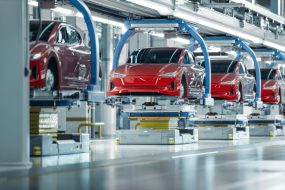If you’re in the world of automotive logistics and supply chain, you’ll know things aren’t exactly business as usual. The whole industry is shifting – fast. New tech, sustainability targets, economic curveballs… it’s all forcing logistics teams, manufacturers, and even parts suppliers to completely rethink how they move things from A to B.
So, what’s actually going on? What’s hype, and what’s here to stay? Let’s explore the biggest moves in automotive logistics right now, and what they mean for you.
Related Reading: 4 Trends in Automotive Supply Chain That Ease Disruptions
1. Multimodal Transport: No More Putting All Your Eggs in One Truck
If your logistics plan still relies on one main mode of transport, it’s probably time to upgrade. Multimodal transport – a smart mix of road, rail, air, and sea – is becoming the go-to for modern automotive logistics providers. Why? Because it’s faster, cheaper in the long run, and way more flexible.
Why this matters:
- You save on costs by avoiding over-reliance on a single (often expensive) transport option.
- Your supply chain becomes more shockproof; if one leg hits a delay, another can pick up the slack.
- It’s greener. Shifting some movement to rail or sea can dramatically lower your carbon footprint.
And with sustainability pressure mounting (from regulators and customers), that last point isn’t optional anymore.
2. Digital Tools Are Doing More Heavy Lifting Than Ever
Yes, the tech buzzwords are everywhere, but for good reason. The digital transformation of the auto logistics space is real, and it’s changing the game.
What’s hot right now?
- IoT and telematics are giving live updates on vehicle conditions, ETA accuracy, and even tyre pressure.
- AI and machine learning are doing the brainwork, predicting demand, flagging delays before they happen, and fine-tuning routes on the fly.
- Blockchain is boosting transparency, helping trace parts and shipments from factory to final destination.
If you’re an automotive 3PL or part of the broader supply chain, not tapping into these tools is like bringing a horse to a Formula 1 track.
Related Reading: Smarter supply chains: How tech is transforming auto logistics
3. Goodbye Throwaway Culture: The Rise of the Circular Economy
This one’s big, and not just for carmakers. The circular economy is reshaping how we design, build, and reuse car parts. Think: remanufacturing engines, refurbishing components, and recycling materials instead of tossing them.
What that means for logistics:
- You’re now dealing with reverse logistics – moving parts backwards through the chain for returns, repairs, and reuses.
- You’ll need systems that can handle different kinds of goods in different conditions, not just shiny new parts.
- Flexibility is key, especially as the flow of goods becomes less linear and more like a loop.
It’s trickier, sure. But it’s also smarter, and more sustainable. And that’s the future.
Related Reading: Sustainable transportation: Innovative solutions for a greener future


4. 3PLs: The Secret Weapon of Automotive Supply Chains
Not everyone has the time, cash or know-how to build a global logistics operation from scratch. That’s where automotive 3PL providers step in – and they’re playing a massive role in reshaping the industry.
Why more companies are teaming up with 3PLs:
- Scalability. Need to ramp up for a launch or cut back during a slowdown? 3PLs make that painless.
- Expertise. The good ones come with cutting-edge tech, global networks, and seasoned teams.
- Reduced risk. When the market zigs, they zag, helping you dodge everything from customs chaos to compliance nightmares.
In short: they let car brands and parts suppliers focus on building great products, while the logistics pros handle the heavy lifting (literally).
5. Global Rules Keep Changing, And You’ve Gotta Keep Up
Trade tensions, tariffs, shifting regulations… navigating the global automotive logistics and supply chain space isn’t getting any easier.
But smart players are tackling it head-on by:
- Diversifying suppliers and routes. Don’t rely too heavily on one region or one mode – it’s risky.
- Staying plugged into policy changes. That might mean hiring compliance experts or using platforms that keep you updated in real time.
- Building agility into the system. Fast reaction times are becoming a competitive advantage.
Bottom line: waiting to adapt until things go wrong is a terrible strategy. The winners are the ones who prepare early.
Related Reading: Exploring the future of supply chain transparency with blockchain technology
Key Takeaway: Keep On Trucking
The world of automotive logistics is evolving fast, and it’s not slowing down any time soon. Whether it’s multimodal transport, digital tools, circular models, or leaning on a savvy automotive logistics provider, the message is clear: adapt or fall behind.
Now’s the time to rethink your supply chain strategy. Because in a landscape shaped by speed, sustainability and smarts, standing still isn’t an option.
Want to chat with a team that’s already helping brands move smarter? Start here.




